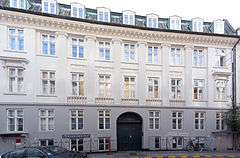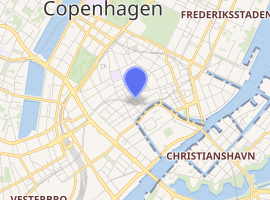Badstuestræde 18
Badstuestræde 18 is a listed Neoclassical property in Badstuestræde in the Old Town of Copenhagen, Denmark.
| Badstuestræde | |
|---|---|
 | |

| |
| General information | |
| Architectural style | Neoclassical |
| Location | Copenhagen |
| Country | Denmark |
| Coordinates | 55°40′40.09″N 12°34′32.02″E |
| Completed | 1797 |
History
The building was constructed for brewer Peter Møller in 1796 and 1797. The previous building at the site had been destroyed in the Copenhagen Fire of 1795.
One of the first tenants in the building was the priest Christian Bastholm (1740-1819). Royal actor Peter Jørgen Frydendahl (1766-1836) was a resident during the period of 1811–1813.[1]
Second ballet master at the Royal Danish Theatre Carl Dahlén and the actress Carl Dahlén lived on the first floor in the early 1820s. Carl Dahlén accepted a young Hans Christian Andersen as a ballet student in 1821. Andersen often visited his home in Badstuestræde.[2]
Supreme Court attorney Gustav Edvard Brock (1816-1878) lived in the building in the period 1849 to 1856. He served as public prosecutor in the impeachment against the Cabinet of Ørsted-Bluhme while he lived in the building.
Carl Seifert, a manufacturer of armed doors and gates, owned the building in around 1940. The company is now based in Ballerup. Erik Myrdahls Bogtrykkeri, a printing business, was based in the building in 1935-1982.
Architecture
The building was likely designed by a pupil of Caspar Frederik Harsdorff. The facade is decorated with six Ionic pilasters.
Today
The building was converted into 16 apartments by Gottlieb & Paludan Arkitekter in 2007.
References
- "Badstuestræde 18". indenforvoldene.dk (in Danish). Retrieved 3 August 2018.
- Jan Gralle. "Walking in Hans Christian Andersen's Copenhagen". Frydenlund. Retrieved 3 August 2018.
External links
| Wikimedia Commons has media related to Badstuestræde 18. |